伪满皇宫导游词英文
长春伪满皇宫导游词文档4篇
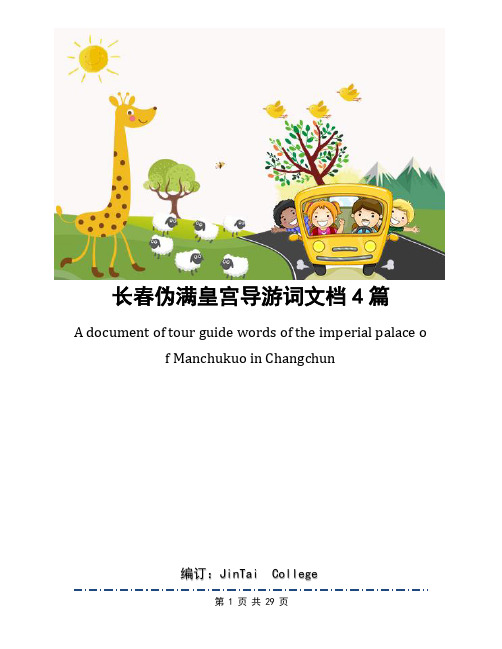
长春伪满皇宫导游词文档4篇A document of tour guide words of the imperial palace of Manchukuo in Changchun编订:JinTai College长春伪满皇宫导游词文档4篇前言:导游词是导游人员引导游客观光游览时的讲解词,是导游员同游客交流思想,向游客传播文化知识的工具,也是应用写作研究的文体之一。
本文档根据导游词内容要求和针对旅游地点是吉林的特点展开说明,具有实践指导意义,便于学习和使用,本文下载后内容可随意调整修改及打印。
本文简要目录如下:【下载该文档后使用Word打开,按住键盘Ctrl键且鼠标单击目录内容即可跳转到对应篇章】1、篇章1:长春伪满皇宫导游词文档2、篇章2:长春伪满皇宫导游词文档3、篇章3:参观长春伪满皇宫文档4、篇章4:吉林伪满皇宫导游词文档伪满皇宫是日本帝国主义武力侵占中国东北,推行法西斯殖民统治的历史见证,很多游客慕名来参观,导游要做好景点的详细介绍。
下面是带来的长春伪满皇宫导游词,希望可以帮到大家。
篇章1:长春伪满皇宫导游词文档伪满皇宫位于长春市东北角的光复路上,占地面积12公顷,是伪满洲国傀儡皇帝爱新觉罗·溥仪的宫殿,他在从1932年到1945年间曾在这里居住。
伪满皇宫的主体建筑是一组黄色琉璃瓦覆顶的二层小楼,包括勤民楼、辑熙楼和同德殿,这三座小楼风格独特,是中西式相结合的格局。
伪皇宫可分为进行政治活动的外廷和日常生活是内廷两部分,现分别辟为伪满皇宫陈列馆和伪满帝宫陈列馆。
外廷(皇宫)是溥仪处理政务的场所,主要建筑有勤民楼、怀远楼、嘉乐殿,勤民楼是溥仪办公的地方。
此外还有花园、假山、养鱼池、游泳池、网球场、高尔夫球场、跑马场以及书画库等其他附属场所。
内廷(帝宫)是溥仪及其家属日常生活的区域,其中辑熙楼是溥仪和皇后婉容的居所,是日常起居之处;同德殿是“福贵人”的居所,另外还设有一些娱乐设施。
国际导游 英文导游词 加译文 《缉熙楼+译文》
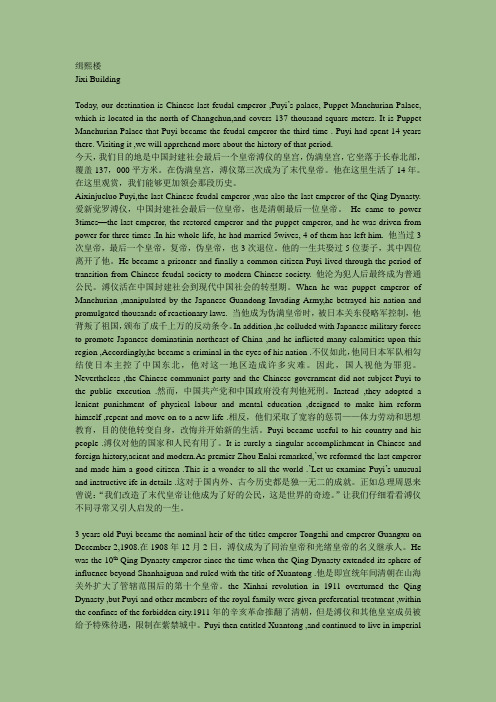
缉熙楼Jixi BuildingToday, our destination is Chinese last feudal emperor ,Puyi’s palace, Puppet Manchurian Palace, which is located in the north of Changchun,and covers 137 thousand square meters. It is Puppet Manchurian Palace that Puyi became the feudal emperor the third time . Puyi had spent 14 years there. Visiting it ,we will apprehend more about the history of that period.今天,我们目的地是中国封建社会最后一个皇帝溥仪的皇宫,伪满皇宫,它坐落于长春北部,覆盖137,000平方米。
在伪满皇宫,溥仪第三次成为了末代皇帝。
他在这里生活了14年。
在这里观赏,我们能够更加领会那段历史。
Aixinjueluo Puyi,the last Chinese feudal emperor ,was also the last emperor of the Qing Dynasty.爱新觉罗溥仪,中国封建社会最后一位皇帝,也是清朝最后一位皇帝。
He came to power 3times—the last emperor, the restored emperor and the puppet emperor, and he was driven from power for three times .In his whole life, he had married 5wives, 4 of them has left him. 他当过3次皇帝,最后一个皇帝,复帝,伪皇帝,也3次退位。
伪满皇宫,英文导游词
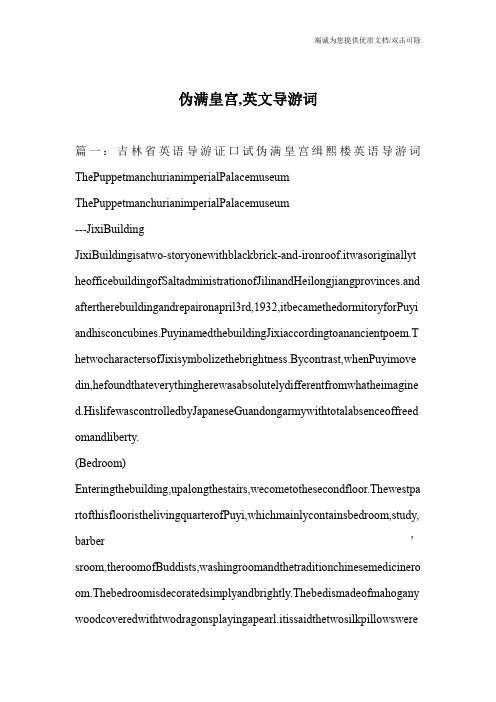
伪满皇宫,英文导游词篇一:吉林省英语导游证口试伪满皇宫缉熙楼英语导游词ThePuppetmanchurianimperialPalacemuseum ThePuppetmanchurianimperialPalacemuseum---JixiBuildingJixiBuildingisatwo-storyonewithblackbrick-and-ironroof.itwasoriginallyt heofficebuildingofSaltadministrationofJilinandHeilongjiangprovinces.and aftertherebuildingandrepaironapril3rd,1932,itbecamethedormitoryforPuyi andhisconcubines.PuyinamedthebuildingJixiaccordingtoanancientpoem.T hetwocharactersofJixisymbolizethebrightness.Bycontrast,whenPuyimove din,hefoundthateverythingherewasabsolutelydifferentfromwhatheimagine d.HislifewascontrolledbyJapaneseGuandongarmywithtotalabsenceoffreed omandliberty.(Bedroom)Enteringthebuilding,upalongthestairs,wecometothesecondfloor.Thewestpa rtofthisflooristhelivingquarterofPuyi,whichmainlycontainsbedroom,study, barber’sroom,theroomofBuddists,washingroomandthetraditionchinesemedicinero om.Thebedroomisdecoratedsimplyandbrightly.Thebedismadeofmahogany woodcoveredwithtwodragonsplayingapearl.itissaidthetwosilkpillowsweremadebyPuyi’sconcubineTanYuling.Puyiwasafraidofhotverymuch.Hegotahabbitofcover ingtowelingcoverletwhensleeping,coveringoneinsummerandtwoinwinter. Somepartofhisbodywaswrappedwithacleansheetwhichwaswashedandchan gedeveryday.Strangelyenough,thereweretwohumanmodels,onemale,anoth erfemale,underhiswindowfacingsouth,coveredbyclothinusual.whenhewen ttobed,Puyialwaysputtheminfrontofhisbed.itissaidthattheyservedasPuyi’sbodyguards.(Study) Theroomconnectingwiththebedroomishisstudy.asapuppet,therewerenoaffa irstodealwith,instead,hespentmoreandmoretimeinJixiBuilding.Hisstudybe cameanotheroffice,andheoftenmetYoshiokahere.Generally,withouthisper mit,nobodywasallowedtoenterhisroom.ButYoshiokawasanexception.more over,hecameinandoutseveraltimesaday.Eachtimehecamein,Puyiwouldstan dupandgreethimbecauseoffright.Lookatthispicture.Thepaintingonthewall waspaintedbyYoshioka.althoughitwasnotwelldone,Puyihungitinthepromin entpositionrespectfully.anotherarrestingarticleintheroomwasthemodelof“Hiji”—aworshipofJapan.whenPuyifirstvisitedJapan,Japanesemadethemod eltosendhimtomakehimmoreclosetoJapan.inapril2nd,1935,arrangedbyGua ndongarmy,PuyibeganhisvoyagebytheworshipforJapanindaliancity.during thevoyage,inordertoexpresshisgratefulness,Puyiscriptedapoem: Japantheworshipsailsfor,Theseaisascalmasamirror.withtwostateshandinhand,Theorientalwillbestrongforever.onmay2nd,fivedaysafterPuyi’sreturningfromJapan,heissuedhisinstructiontoadvocatethefriendshipbetwe enJapanandchina.HeoftensaidthatchinaandJapanshouldbeofoneheartandon emind.(Barber’sRoom)Puyi’sbarber’sroomisnotbig,butwell-equiped.TherewasaJapanesehairdresserservinghim only,whosenamewasTsuta.whenhefinishedhisjob,Puyiwouldwrapthehairin ayellowpieceluster,writingtheandkeepingitwelltoshowhischerishofhishair.Besides, itwasthedisinfectingroom.Puyiwasinjectedwithimportedtonichormone,and alltheinstrumentsusedmustbedisinfectedhere.asamysophobia,Puyichanged andwashedhisshirteveryday.Eveninsummer,hebroughtanalcoholboxwithhi manytime.Evenifaflyfellonhisbody,hewouldcleanitwithalcoholcottonincas eofgettinginfected.(RoomofBuddists) PuyihadbeenadevoutBuddistsincehischildhood,sofarastobesuperstitious.w heneverhewentoutorhadimportantactivities,hewoulddivinebymeansoftheE ightdiagramspredictinghisfuture.Sometimesitwouldlastoneortwohoursunti lhewasentirelysatisfiedwithhisoutcome.asJapaneselostitsdominancegradually,Puyiwasathisgloomydays.Eating,sleeping,jerkinglotsanddivingwereth eonlythingshecoulddo.Thepalacewaslikeatemple.Hebeatswoodenfishdaya ndnight.However,Puyishowednosympathytohisservants.Takingtheteenage rsservingascleanersforexample,theywork15~16hoursperdayandtheyhadto workatnight.Theydidthehardestjobandatetheworstfoodsothattheywerethin andpale.Theywouldbepunished,beatenandevenimprisonedforsomelittleerr ors.intheyearof1944,oneoftheteenagersnamedSunBoyuancouldn’tbearthesufferingandtriedtoescapetwice.Hewasbeatentodeathatlast.Puyidi dn’tthinkthatitwashisfaultbutblamedontotheonewhobeatSunBoyuanandpunis hedhim.afterthataccident,heprayedforhimjustbecausehewasafraidoftherev engeofSunBoyuan’sghost.(Bathroom)inth()eoppositesideofthebedroomwashistoilet,thebathroomandthewashroo m.canyoufindsomethingdifferent?Yes.Therewasasmallwoodendeskwithne wspapersandmagazinesonit.why?That’sbecausePuyisufferedserioushemorrhoids,sohehadtositonthetoiletseatforal ongtime.Therefore,hedevelopedintoahabbitofreadingandsigningthememor ialsinthetoilet.Everytimethememorialpresenterhandedthedocumentstohim, hewouldsignthemwithoutreadingit,thendroppedthedocumentsontothefloor. Thepresenterpickedthemuponebyoneandwentout.alotofreactionarydocum entsweresignedinthisway.maybePuyineverthoughthissuchbehavioursbroughtalotofdisasterstothepeopleinthenortheast.(chinesedrugStore) Puyihadbeenunhealthysincehewasachild,orwecansay,hecoulddoctorhimsel fbecausehewasillforalongtime.Hewasevenaddictedtotakingandcollecting medicine.Therefore,hesetupachinesedrugstorebesideshisroom.Puyihadhad readalotofmedicalbooks,whichmadehimamasterofTraditionalchinesemedi cinemoreorless.atthattime,therewerefourimperialdoctorswhodiagnosehim byturn.Everydaytheywouldfeelhispulseevenifhewasnotill.Hewouldaskdoc torforwritingaprescriptionandboilingdownmedicalherbswellservingastea,b utwereuseless.Puyididn’ttakethem.whenhereallywantedtotakemedicine,hewouldaddorreducesome medicineherbsofftheprescriptionbytheimperialdoctorsorhewouldrewritean ewprescriptionandcarrymedicinefromchinesedrugstoreinperson. (wanrong) intheeasternpartofthesecondflooristhelivingquarterofEmpresswanrong,co nsistingofabedroom,astudy,aroomofsmokingopiumandbathroom.wanrong, amanchuinzhengbaiBanner,wasborninTianjinin1906.Shewaswell-educate dandcouldspeakEnglishfluently.Shewasnotonlybeautifulbutalsoexcelledin luteplaying,chess,calligraphyandpainting.Herbeautyandintelligencewerere nownedintheBanner.indecemberof1922,thesixteen-year-old girlwanrongandPuyiheldagreatweddingceremonyintheForbiddencity.inma rchof1932,shecametochangchunwithPuyiandbecametheEmpressofPuppetEmperor.Becauseshedidn’tgetalongwellwithPuyiandherspirituallifewasblank,shehadsecretrelationsh ipwithPuyi’sservant.Puyidesertedherafterheknewthetruth.Fromthenon,shewasdrivenin tothelimboandconfinedtotheeasternpartofthesecondfloor.inordertoremovet heempress,PuyifoundanexcuseoftakinghertoLvshun.Becauseofwanrong’srefusalandJapaneseGuandongarmy’sinterruption,theplanwasinvain.althoughwanronglivedsoneartoherhusband ,infact,shewasisolatedfromoutside.Shecouldn’tseeherrelatives.Shewastorturedbothphysicallyandmentally.inordertoreliev ethepain,shehadnowaybutlayonbedtoanaesthetizeherbysmoking.Heradditi onbecamehavierandhavierdaybyday.Shesmoked100gramsofopiumperday. Everytimesheusedeightpipeswitheighty-fivecigarettes.Sheevencouldn’tlivewithoutopiumandsufferedfromschizophrenia.assheconfinedherselfint heroom,hereyesfearedlightandshealsocouldn’twalknormally.afterthePuppetEmperorcollapsed,wanrongescapedwithPuyi todalizigou,Tonghuacity.onJune20th,1946,wanrongdiedinYanjionthewayo fescaping.ifshewouldn’thavefollowedPuyitochangchunasapuppetempressatthatmoment,howwoul dthebrilliantbeautyhavehadsotragicfate?comparedwithwanrong,anotherim peralconcubinewenxiuwaslucky.Sheenteredthepalaceatthesametimewithw anrong,butshewasanindependentandprogressivefemale.inoctoberof1931,unbearingPuyi’sdesolationandwanrong’sinsult,sheresolutelydevoicedwithPuyiinTianjinandlivedaself-reliantlife.H owever,wanronglovedvanitysomuchthatshebecameavictimofPuyiandfeud alsystem.(TanYuling) inthewesternpartofthefirstfloorofJixiBuildinglivedPuyi’sthirdwife,TanY uling.Thispartcontainsthebedroom,study,sittingroom,livin groomandbathroom.afterwanrongwasputintothelimbo,PuyimarriedTanYul ing,amiddleschoolstudentinBeijingin1937.TanYulingwaschosenbyPuyiatt heageof17.ShewassoconsideratethatwhenPuyigotangryandshoutedather,or evenhetoreherclothes,shewouldnotgetannoyed.onthecontary,shewouldtryt opersuadePuyitocalmhimselfdown.Hence,shewonhisfavor.onthewaytocha ngchuncity,shewitnessedwhattheJapanesehaddonetothechinesepeople,soin chattingwithPuyi,shewouldslightlyexposeherdissatisfaction.in1942,shebe cameillandwasconsideredbeinginfectbytyphoidfever.Butthemedicinedidn ’ter,withtherecommendationofYoshioka,aJapane sedoctornamedounoderacametotureher.ounoderabelievedthatshehadgottub erculosisandbeganhistreatment.However,allhiseffortfailed.Finallyafterthe doctorhadalongtalkwithYoshioka,heinjectedsomethingtoher.andshediedbe forethenextdawnattheageof22.Herdeathremainsamysterytilltoday.Puyisus pectedthattheJapanesekilledherandheevenexclaimedthisonthemilitarycour t.inordertomemorizeTanyuli ng,Puyiwrotedown“Yulingmybeloved”onthebackofherphoto.Furthermore,theemperorevenkepthernailsandawispofherbl ackhairtogetherwiththephotointoawalletandbroughtitwhereverhewent.onh erfuneral,PuyiarrangedmanyspecializedorchidsnamedJunzilantobeputalon ghercoffin,fortheseflowerswereTanyuling’sfavoriteandalsopeculiarwithinPuyi’tertheseorchidswerebredint hetempleandbecamethemostfamoustypeoforchids.Thefolkscalledthem“he shangtou”meaningtheheadofmonks.Untilthecollapseofthepuppetregi me,P uyifinallyagreedtocremateherbodyandtheasheswastakentoBeijing.withsev eralturnarounds,Tanyuling’sasheswerekeptinthismuseumafterall. ThevisitofJixiBuildingisover.PleasefollowmetoTongdeBuilding.篇二:伪满皇宫缉熙楼导游词伪满皇宫缉熙楼导游词女士们先生们:大家好!欢迎您欢迎各位到长春伪满皇宫缉熙楼观光旅游。
伪满皇宫英文导游词
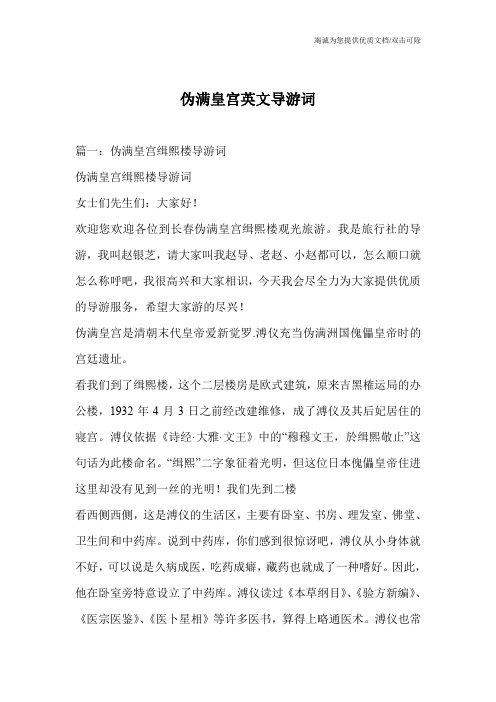
伪满皇宫英文导游词篇一:伪满皇宫缉熙楼导游词伪满皇宫缉熙楼导游词女士们先生们:大家好!欢迎您欢迎各位到长春伪满皇宫缉熙楼观光旅游。
我是旅行社的导游,我叫赵银芝,请大家叫我赵导、老赵、小赵都可以,怎么顺口就怎么称呼吧,我很高兴和大家相识,今天我会尽全力为大家提供优质的导游服务,希望大家游的尽兴!伪满皇宫是清朝末代皇帝爱新觉罗.溥仪充当伪满洲国傀儡皇帝时的宫廷遗址。
看我们到了缉熙楼,这个二层楼房是欧式建筑,原来吉黑榷运局的办公楼,1932年4月3日之前经改建维修,成了溥仪及其后妃居住的寝宫。
溥仪依据《诗经·大雅·文王》中的“穆穆文王,於缉熙敬止”这句话为此楼命名。
“缉熙”二字象征着光明,但这位日本傀儡皇帝住进这里却没有见到一丝的光明!我们先到二楼看西侧西侧,这是溥仪的生活区,主要有卧室、书房、理发室、佛堂、卫生间和中药库。
说到中药库,你们感到很惊讶吧,溥仪从小身体就不好,可以说是久病成医,吃药成癖,藏药也就成了一种嗜好。
因此,他在卧室旁特意设立了中药库。
溥仪读过《本草纲目》、《验方新编》、《医宗医鉴》、《医卜星相》等许多医书,算得上略通医术。
溥仪也常常在这里接见“帝室御用挂”吉冈安直。
这是溥仪的理发室,虽然不大,但理发用具却是一应俱全。
有一个叫津田的日本人专门为溥仪理发,每次剪下来的头发都要用黄绢包起来,标明日期,妥善保存起来,以示对其龙发的珍视。
这里也用做消毒室,溥仪用的注射用具,也在此消毒。
溥仪有洁癖,不仅衬衣每天必须换洗,而且到了夏季,他还随身携带酒精盒,即便苍蝇落在身上,也要用酒精棉擦拭消毒,以免沾染“细菌”。
我们再看看卫生间,分为浴室和厕所两个房间。
与众不同的是,抽水马桶的旁边还设有一个小木桌,放着报纸、杂志。
这是为什么呢?原来,溥仪患有痔疮病,严重时,入厕的时间特别长,为此渐渐地养成了坐在马桶上读书看报、裁可奏折的习惯。
对于奏事官呈递上来的奏折及一些反动法令等,溥仪连看都不看一眼,拿起笔来就裁可,然后扔到地上,奏事官再一一捡起来退这么一扔、一捡就中国人带来了把无数的灾难啊!我们再到东侧参观,这是皇后婉容的生活区。
有关吉林伪满皇宫的导游词范文

( 吉林导游词)姓名:____________________单位:____________________日期:____________________编号:YB-BH-037515有关吉林伪满皇宫的导游词范On the tour guide words of the imperial palace of Manchukuo in有关吉林伪满皇宫的导游词范文5篇有关吉林伪满皇宫的导游词范文(一)各位观众朋友们:您们好!欢迎您参观伪满皇宫。
伪满皇宫,位于长春市东北部,是清朝末代皇帝爱新觉罗·溥仪充当伪满洲国傀儡皇帝时的宫廷遗址。
它虽然没有中国传统皇宫那般庄严肃穆,也不像西方宫殿那般宏伟壮观,但建筑风格仍有自己的独特之处;既有中国旧式带廊瓦房,又有“中日合璧”的殿堂,还有欧式情调的楼宇,可谓古今杂陈,中外并举。
宫廷占地总面积13.7万平方米,略呈南北窄而东西宽的梯形。
外周为993米长宫墙所围,内有围墙368米,附岗楼11座,共有宫门7座。
伪满皇宫正门位于南部,称莱薰门,此门伪满时期专供“皇帝”溥仪、日本关东军司令官及来伪满访问的各国政府首脑出入使用;莱薰门的西部有专供伪满官吏和其他有资格者出入的侧门——保康门,它有“保卫康德”的含义(“康德”是伪满洲国傀儡皇帝溥仪的年号);莱薰门以东有出入建国神庙及伪祭祀府派驻帝宫内管理祭祀的机构庙务所的日式鸟居门;北面由西向东分别为体乾门、福华门、含宏门;西面有一禁卫门。
内部宫门主要有仅供溥仪及其眷属日常出入使用的长春门、伪满皇宫东区的正门同德门及日伪官吏进出伪满皇宫西区外廷的必经之门——兴运门和迎晖门、伪满皇宫西区内廷与外廷的分界线——中和门等。
兴运门建成于1934年1月,时值溥仪第三次登基做伪满洲国皇帝前夕,溥仪认为自己即将成为xx 至尊,便命人在其门楣上雕刻二龙戏珠图案,并亲自将其命名为“兴运门”,希望国运从此兴隆。
伪满皇宫主体部分为4.6万平方米,分为东西两个不对称的区域。
长春伪满皇宫英语作文
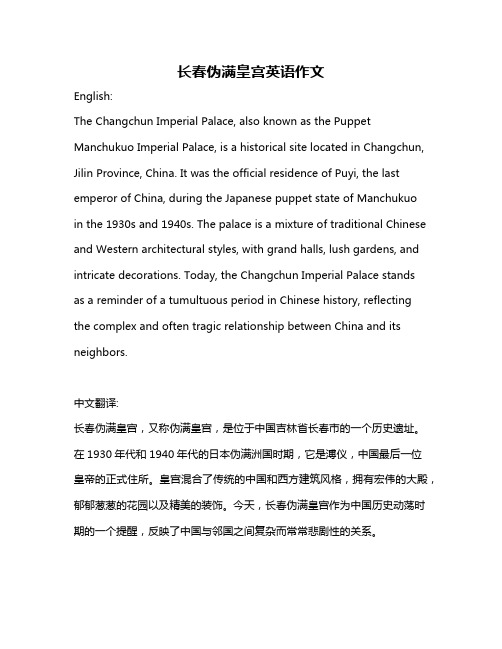
长春伪满皇宫英语作文English:The Changchun Imperial Palace, also known as the Puppet Manchukuo Imperial Palace, is a historical site located in Changchun, Jilin Province, China. It was the official residence of Puyi, the last emperor of China, during the Japanese puppet state of Manchukuoin the 1930s and 1940s. The palace is a mixture of traditional Chinese and Western architectural styles, with grand halls, lush gardens, and intricate decorations. Today, the Changchun Imperial Palace standsas a reminder of a tumultuous period in Chinese history, reflectingthe complex and often tragic relationship between China and its neighbors.中文翻译:长春伪满皇宫,又称伪满皇宫,是位于中国吉林省长春市的一个历史遗址。
在1930年代和1940年代的日本伪满洲国时期,它是溥仪,中国最后一位皇帝的正式住所。
皇宫混合了传统的中国和西方建筑风格,拥有宏伟的大殿,郁郁葱葱的花园以及精美的装饰。
今天,长春伪满皇宫作为中国历史动荡时期的一个提醒,反映了中国与邻国之间复杂而常常悲剧性的关系。
英语作文welcome to长春伪满皇宫
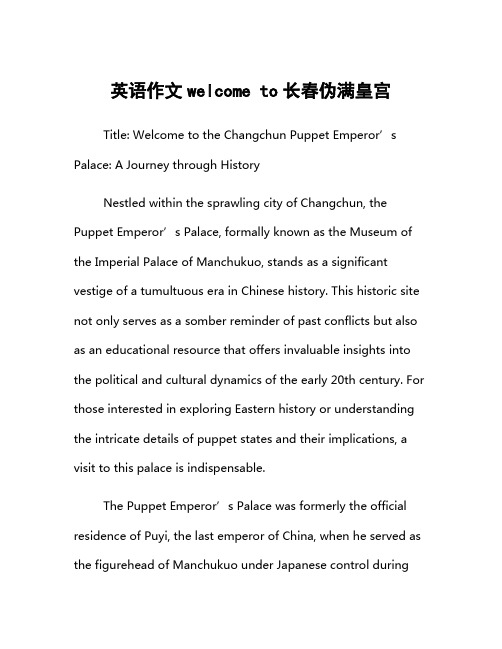
英语作文welcome to长春伪满皇宫Title: Welcome to the Changchun Puppet Emperor’s Palace: A Journey through HistoryNestled within the sprawling city of Changchun, the Puppet Emperor’s Palace, formally known as the Museum of the Imperial Palace of Manchukuo, stands as a significant vestige of a tumultuous era in Chinese history. This historic site not only serves as a somber reminder of past conflicts but also as an educational resource that offers invaluable insights into the political and cultural dynamics of the early 20th century. For those interested in exploring Eastern history or understanding the intricate details of puppet states and their implications, a visit to this palace is indispensable.The Puppet Emperor’s Palace was formerly the official residence of Puyi, the last emperor of China, when he served as the figurehead of Manchukuo under Japanese control duringWorld War II. The architecture and exhibitions housed within reflect a unique blend of Chinese and Japanese influences, capturing the complex interplay between these two cultures during Japan’s occupation of Manchuria.The story of the Puppet Emperor’s Palace begins in the early 1930s, when Japan established Manchukuo as a puppet state after their invasion and subsequent control over Manchuria. Puyi, who had abdicated his throne in 1912 after the fall of the Qing Dynasty, was installed as the emperor of this new state. The palace originally functioned as his administrative headquarters and living quarters, symbolizing both his nominal power and actual impotence as a political tool manipulated by Japanese interests.Designed by Japanese architects and built with a fusion of traditional Japanese and Chinese architectural styles, the palace was intended to legitimize Puyi’s rule and reinforce the notion of Manchukuo’s sovereignty. However, despite its grandeur, itwas clear that real power resided firmly in Japanese hands. Visiting this site provides a poignant look at Puyi’s constrained role and his tumultuous life which was marked by manipulation and loss of autonomy.As you walk through the expansive grounds of the palace today, it is impossible to miss the ornate decorations and meticulously maintained gardens that contrast starkly with its somber past. The main building is comprised of numerous halls used for state affairs, private residences for Puyi and his family, and offices for Japanese advisors who played critical roles in government decision-making.One of the most fascinating exhibitions within the palace is Puyi’s personal study room. Here o ne can find relics from his daily life, including his pen, books, personal photographs, and even gifts from Japanese officials. These personal artifacts provide visitors with a more intimate perspective on Puyi as a person rather than just a political figurehead.Similarly, other sections of the museum detail multiple aspects of life in Manchukuo, providing context on everything from social policies implemented by Japanese authorities to resistance movements led by local Chinese citizens. Each section is supplemented with authentic artifacts from that era, ranging from government documents and military uniforms to cultural items that showcase everyday life during this difficult period.For visitors, touring this historic site is an exercise in reflection about how history is constructed and remembered. It prompts deep thoughts about themes such as war and peace, nationalism and colonialism, autonomy and control. Understanding these global issues through the lens of a local story enables deeper appreciation for how local events can have international consequences.Moreover, it invites discussions on reconciliation and healing post-conflict. Observing Japan’s attempts at ruling through puppetry provides critical insights into how imperialambitions can severely impact subjected nations socially, politically, culturally – and how these impacts may linger long after direct rule has ended.In conclusion, paying a visit to Changchun’s Puppet Emperor’s Palace is not just about witnessing historical artifacts or admiring architectural marvels but about deeply understanding how such installations fit within broader global narratives. This historic site serves both as a poignant reminder of Manchuria’s troubled past under Japanese occupation and an educational experience that sheds light on complicated historical dynamics that continue to inform present-day relationships not only between China and Japan but globally.A trip here promises visitors not just a tour through once-royal hallways but journeys through era-defining events that shaped much of East Asia’s contemporary landscape. Stand in places where history was made; see through lenses that reveal not just what happened but delve into why it happened –visiting Changchun’s Puppet Emperor’s Palace thus turns into both an enlightening educational opportunity and an immersive historical introspection.。
伪满皇宫的英语作文
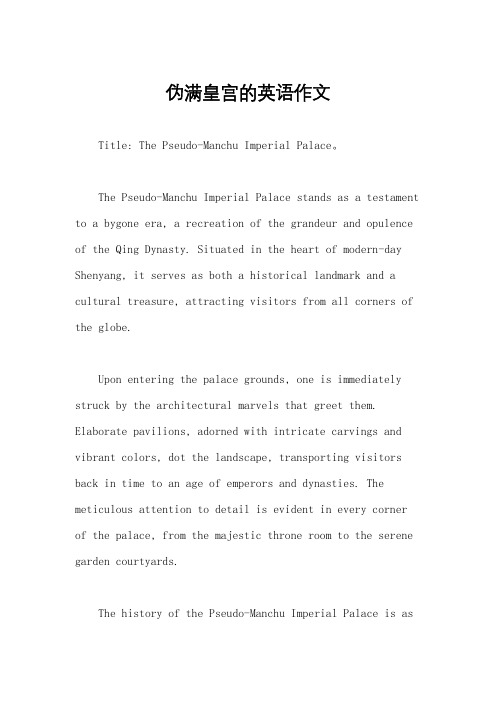
伪满皇宫的英语作文Title: The Pseudo-Manchu Imperial Palace。
The Pseudo-Manchu Imperial Palace stands as a testament to a bygone era, a recreation of the grandeur and opulence of the Qing Dynasty. Situated in the heart of modern-day Shenyang, it serves as both a historical landmark and a cultural treasure, attracting visitors from all corners of the globe.Upon entering the palace grounds, one is immediately struck by the architectural marvels that greet them. Elaborate pavilions, adorned with intricate carvings and vibrant colors, dot the landscape, transporting visitors back in time to an age of emperors and dynasties. The meticulous attention to detail is evident in every corner of the palace, from the majestic throne room to the serene garden courtyards.The history of the Pseudo-Manchu Imperial Palace is asfascinating as its architecture. Built in the late 20th century, it was the brainchild of a group of passionate historians and architects who sought to recreate the splendor of the original Qing Dynasty palace, which had long since been lost to the ravages of time. Drawing upon historical records, architectural plans, and cultural artifacts, they embarked on a monumental undertaking to resurrect this cultural icon from the past.However, the palace is more than just a faithful recreation of its historical counterpart; it is also a symbol of cultural revival and national pride. In a rapidly modernizing world, where traditional values and customs often take a backseat to progress, the Pseudo-Manchu Imperial Palace serves as a reminder of the importance of preserving and celebrating our cultural heritage. It is a place where visitors can immerse themselves in the rich tapestry of Chinese history, gaining a deeper appreciation for the customs and traditions that have shaped our society for centuries.Moreover, the palace plays a vital role in promotingtourism and economic development in the region. Its sheer beauty and historical significance draw tourists from far and wide, injecting vital revenue into the local economy and supporting countless jobs in the hospitality and service industries. In addition, the palace serves as a focal point for cultural events and celebrations, further enhancing its appeal as a tourist destination.Despite its modern origins, the Pseudo-Manchu Imperial Palace remains true to the spirit of its historical predecessor. It is a living testament to the enduring legacy of the Qing Dynasty, a monument to the ingenuity and creativity of its creators, and a source of inspiration for generations to come. As visitors wander its hallowed halls and marvel at its splendor, they are transported back in time to a world of emperors and concubines, warriors and poets, where history comes alive in all its majestic glory.In conclusion, the Pseudo-Manchu Imperial Palace is more than just a historical landmark; it is a living testament to the enduring legacy of China's rich cultural heritage. From its awe-inspiring architecture to itsfascinating history, it continues to captivate the hearts and minds of all who visit, serving as a symbol of national pride and cultural revival. As we look to the future, may the palace stand as a beacon of hope and inspiration, reminding us of the importance of preserving our past for generations to come.。
长春伪满皇宫英语作文
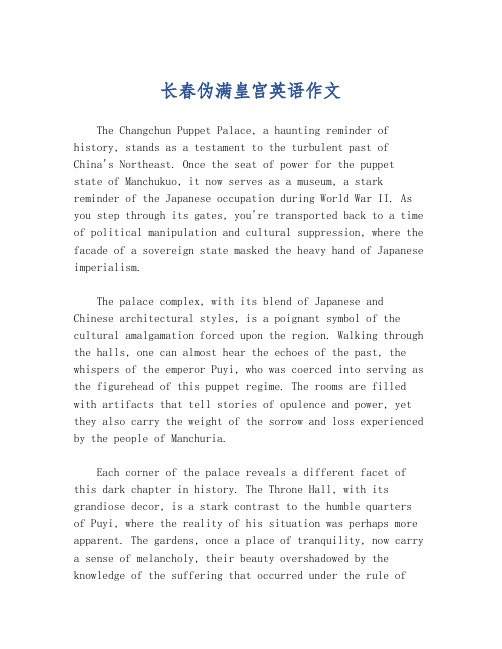
长春伪满皇宫英语作文The Changchun Puppet Palace, a haunting reminder of history, stands as a testament to the turbulent past ofChina's Northeast. Once the seat of power for the puppetstate of Manchukuo, it now serves as a museum, a stark reminder of the Japanese occupation during World War II. As you step through its gates, you're transported back to a time of political manipulation and cultural suppression, where the facade of a sovereign state masked the heavy hand of Japanese imperialism.The palace complex, with its blend of Japanese and Chinese architectural styles, is a poignant symbol of the cultural amalgamation forced upon the region. Walking through the halls, one can almost hear the echoes of the past, the whispers of the emperor Puyi, who was coerced into serving as the figurehead of this puppet regime. The rooms are filled with artifacts that tell stories of opulence and power, yet they also carry the weight of the sorrow and loss experienced by the people of Manchuria.Each corner of the palace reveals a different facet of this dark chapter in history. The Throne Hall, with its grandiose decor, is a stark contrast to the humble quarters of Puyi, where the reality of his situation was perhaps more apparent. The gardens, once a place of tranquility, now carry a sense of melancholy, their beauty overshadowed by the knowledge of the suffering that occurred under the rule ofthe puppet state.Visitors to the Changchun Puppet Palace are not just tourists; they are witnesses to history. The museum does not shy away from the harsh realities of the time, offering exhibits that delve into the political machinations and the human cost of the occupation. It is a place of reflection, where one can ponder the complexities of power, theresilience of the human spirit, and the lessons that can be drawn from the past.As the sun sets over the Changchun Puppet Palace, casting long shadows over its silent walls, it serves as a solemn reminder of the ghosts that still linger within. It is a place that compels us to remember, to learn, and to ensure that such a chapter of history is never repeated. The Changchun Puppet Palace is more than just a building; it is a monument to the resilience of a people and a beacon of hope for a future built on the lessons of the past.。
介绍伪满皇宫的作文

介绍伪满皇宫的作文英文回答:The Pseudo-Manchu Palace, also known as the False Manchu Palace, is a historical site located in the northeastern region of China. It was built during the Qing Dynasty and served as a residence for the emperors andtheir families. The palace is known for its unique architectural style, blending elements of both Chinese and Manchu cultures.The Pseudo-Manchu Palace is a grand complex consisting of numerous buildings, gardens, and courtyards. The main hall, known as the Hall of Supreme Harmony, is the largest and most important building in the palace. It was used for important ceremonies and state affairs. The hall is adorned with intricate wood carvings, vibrant paintings, and exquisite porcelain decorations.The palace also features beautiful gardens withcarefully manicured landscapes, pavilions, and water features. The gardens were designed to create a serene and harmonious environment, reflecting the traditional Chinese belief in the importance of nature.In addition to its architectural beauty, the Pseudo-Manchu Palace holds significant historical and cultural value. It served as the political and cultural center of the Qing Dynasty, playing a crucial role in shaping the history of China. The palace is also home to a vast collection of artifacts, including imperial robes, jewelry, and ancient manuscripts, providing insights into the lifestyle and customs of the imperial family.中文回答:伪满皇宫,又称为假满皇宫,位于中国东北地区的一个历史遗址。
伪满皇宫博物院作文
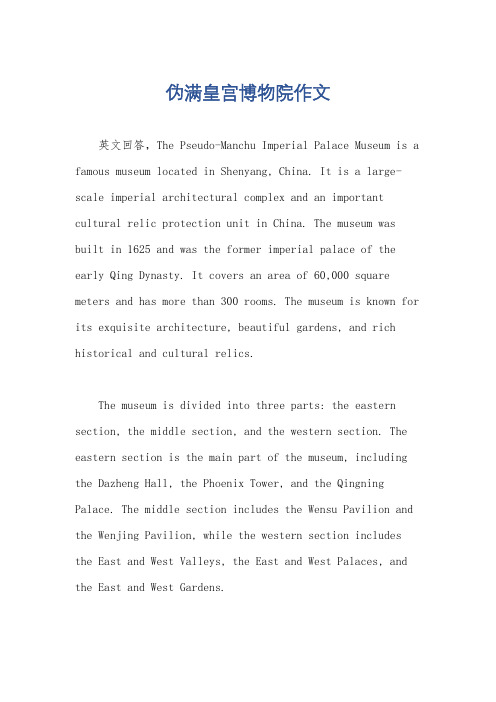
伪满皇宫博物院作文英文回答,The Pseudo-Manchu Imperial Palace Museum is a famous museum located in Shenyang, China. It is a large-scale imperial architectural complex and an important cultural relic protection unit in China. The museum was built in 1625 and was the former imperial palace of the early Qing Dynasty. It covers an area of 60,000 square meters and has more than 300 rooms. The museum is known for its exquisite architecture, beautiful gardens, and rich historical and cultural relics.The museum is divided into three parts: the eastern section, the middle section, and the western section. The eastern section is the main part of the museum, including the Dazheng Hall, the Phoenix Tower, and the Qingning Palace. The middle section includes the Wensu Pavilion and the Wenjing Pavilion, while the western section includes the East and West Valleys, the East and West Palaces, and the East and West Gardens.The Pseudo-Manchu Imperial Palace Museum is not only a historical and cultural treasure but also a popular tourist attraction. It attracts millions of visitors from all over the world every year. Visitors can not only appreciate the magnificent architecture and precious cultural relics but also learn about the history and culture of the Qing Dynasty.中文回答,伪满皇宫博物院是中国辽宁省沈阳市的一座著名博物馆。
介绍伪满皇宫英文作文
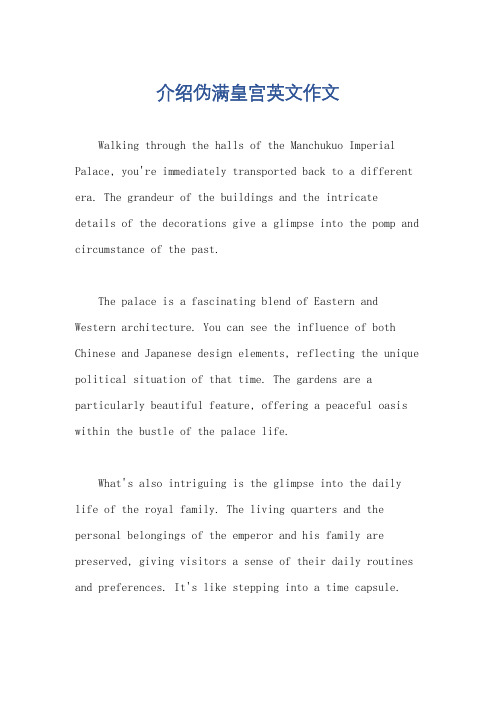
介绍伪满皇宫英文作文Walking through the halls of the Manchukuo Imperial Palace, you're immediately transported back to a different era. The grandeur of the buildings and the intricatedetails of the decorations give a glimpse into the pomp and circumstance of the past.The palace is a fascinating blend of Eastern and Western architecture. You can see the influence of both Chinese and Japanese design elements, reflecting the unique political situation of that time. The gardens are a particularly beautiful feature, offering a peaceful oasis within the bustle of the palace life.What's also intriguing is the glimpse into the daily life of the royal family. The living quarters and the personal belongings of the emperor and his family are preserved, giving visitors a sense of their daily routines and preferences. It's like stepping into a time capsule.But the palace is not just a museum piece. It's also a reminder of a dark period in history. The signs of oppression and control are evident in the layout and design of the palace, a stark contrast to the beauty and splendor on the surface.Visiting the Manchukuo Imperial Palace is a unique experience. It's a chance to explore a bygone era, appreciate the artistry of the past, and also reflect on the complexities and tragedies of history. Whether you're interested in architecture, history, or just curious about what life was like for the royal family, this place is worth a visit.。
英语作文welcome to长春伪满皇宫

英语作文welcome to长春伪满皇宫Welcome to Changchun Imperial Palace! 长春伪满洲皇宫欢迎您的到来!As you step into this historical site, you will be transported back in time to the era of the Qing Dynasty. 一踏入这座历史遗址,您将被带回到清朝的时代。
The grandeur and majesty of the palace will surely leave you in awe. 宏伟壮丽的皇宫必定会让您感到惊叹。
With its intricate architecture and rich history, the Changchun Imperial Palace is a true gem of Chinese heritage. 长春伪满洲皇宫以其错综复杂的建筑和丰富的历史而成为中国文化遗产的瑰宝。
As you wander through the halls and courtyards of the palace, you can almost hear the echoes of the emperors and empresses who once resided here. 当您穿行在皇宫的大殿和庭院间时,几乎可以听到曾在此居住的皇帝和皇后的回音。
The stories and legends of the past come to life as you explore the various rooms and chambers of the palace. 当您探索皇宫的各个房间和室内时,过去的故事和传说仿佛活跃起来。
Each corner of the palace holds a piece of history waiting to be uncovered. 每一个角落都隐藏着等待被揭示的历史。
观伪满皇宫,表你我心声英语作文
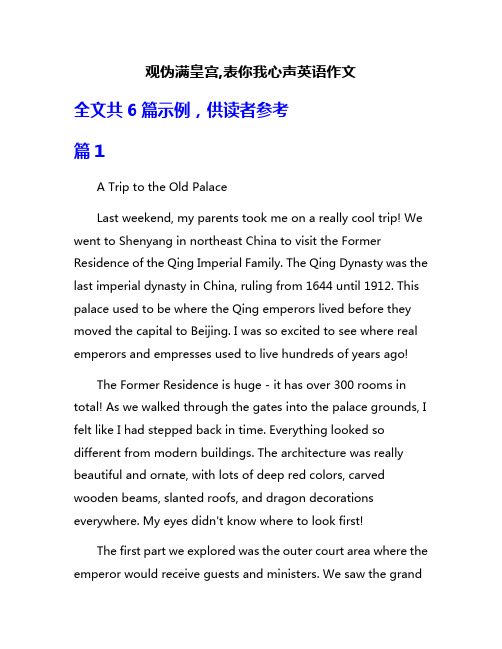
观伪满皇宫,表你我心声英语作文全文共6篇示例,供读者参考篇1A Trip to the Old PalaceLast weekend, my parents took me on a really cool trip! We went to Shenyang in northeast China to visit the Former Residence of the Qing Imperial Family. The Qing Dynasty was the last imperial dynasty in China, ruling from 1644 until 1912. This palace used to be where the Qing emperors lived before they moved the capital to Beijing. I was so excited to see where real emperors and empresses used to live hundreds of years ago!The Former Residence is huge - it has over 300 rooms in total! As we walked through the gates into the palace grounds, I felt like I had stepped back in time. Everything looked so different from modern buildings. The architecture was really beautiful and ornate, with lots of deep red colors, carved wooden beams, slanted roofs, and dragon decorations everywhere. My eyes didn't know where to look first!The first part we explored was the outer court area where the emperor would receive guests and ministers. We saw the grandentrances, ceremonial spaces, offices, and living quarters for guards and servants. One of the coolest things was the Stone Carving Art Gallery which had incredible carved stone animals, people, and landscapes. The details were amazing! My favorite was probably the carved camels.Then we went into the inner court area which was just for the imperial family. We toured the private residences, gardens, and temples. This part felt much more cozy and personal compared to the business-like outer court. I loved peeking into the beautifully decorated bedrooms and seeing all the intricate wood and brick carvings, painted ceiling beams, patterned windows, and colorful vases.One of my favorite parts was the Imperial Garden. It had these lovely winding covered pathways, rock gardens, ponds, and hidden alcoves. I could imagine the emperor and empress taking leisurely strolls through here and admiring the scenery. The garden made me feel so calm and peaceful. I told my parents I wished we had a garden like that at home!Another part I found fascinating was the Qing Dynasty Museum inside the palace. It had so many amazing artifacts and treasures from imperial life - elaborate robes, pottery, jade carvings, paintings, weaponry, and more. There were displaysexplaining all the rules and traditions of the imperial court. I didn't realize how strict and regimented their lives were! Everywhere you looked there were poems, calligraphy, and symbolic meanings. I tried to soak it all in.My brain was bursting with all the history I was learning. The audio guides we rented were super helpful for understanding what everything was. I just couldn't believe people actually lived surrounded by these lavish decorations and solemn ceremonies hundreds of years ago.After hours of exploring, we were all getting hungry so we stopped for lunch at a restaurant right outside the palace gates. We ate delicious Northeastern Chinese dishes like di san xian (a yummy potato, eggplant and green pepper dish), jiaozi (dumplings), and lao niang bao bao (steamed buns stuffed with pork). My favorite was the lao niang bao bao - they were so soft and filling! I'll have to ask my mom to try making those at home sometime.As we ate, I thought more about my impressions of the Former Residence. I have so much admiration for the skilled artisans who created every inch of those incredible buildings and gardens. The level of craftsmanship and attention to detail is just mind-blowing, especially since they did it all without modernmachinery! I feel sad that the last emperor, Puyi, had to leave when he was just a young boy and never got to fully experience palace life.I'm also really grateful that this piece of Chinese history has been so well preserved. It gives me a vivid window into understanding how Chinese imperial society used to function. Even though it's from a different era, I somehow felt a connection to the people who lived there through the spaces they inhabited and things they used in their daily lives. It's pretty wild to imagine the drastic changes China has gone through since then!At the same time, parts of imperial life seem almost funny or silly to me now. Like how there were so many bizarre superstitions and customs the emperor had to follow. Or how the imperial harem had hundreds of ladies-in-waiting whose main job was to keep the emperor entertained and brush his hair! The social hierarchy and rules separating classes seem so outdated to my modern perspective. While the opulent palaces and precious artifacts are beautiful, I'm glad I don't have to deal with all those restrictions and customs.Overall, I had an incredible experience getting to explore this living museum of dynastic China. It's a special opportunity toexperience grandeur on an epic scale. The mix of solemn ceremonies and lavish luxury gives me a deep篇2A Trip to the Mukden Palace - My Heart's VoiceWow, what an amazing place the Mukden Palace is! I had been really looking forward to our school field trip there, and it was even better than I imagined. The palace used to be home to the Qing dynasty emperors before they ruled in Beijing. Just walking through the gates made me feel like I had traveled back in time hundreds of years.The first thing I noticed were the brightly colored glazed tiles on the roofs of the palace buildings. They shimmered in the sun with layers of green, yellow, blue and other colors. Our guide told us that in ancient times, only the emperor was allowed to have yellow roof tiles, because yellow represented imperial power. The tiles almost seemed to glow against the blue sky. I could have stared at them all day!Next we wandered into the private living quarters where the emperors and their families lived. The rooms were furnished with intricate wooden carvings, delicate artworks, and luxurious silk curtains and bedding. I couldn't believe how ornate and detailedeverything was. The craftsmanship was extraordinary. I ran my hands along the carved designs, trying to imagine what it must have been like to live in such splendor as an emperor or empress.My favorite section was probably the garden areas with their beautiful landscapes of ponds, rock formations, pavilions and miniature mountains. The Japanese style gardens were so tranquil and zen. I could picture the emperors strolling through, taking in the scenery and finding peace there. The gardens made me feel calm and relaxed too as I meandered along the winding pathways.The biggest "wow" moment was stepping into the throne room of the Qing Imperial Palace. The throne itself was huge and completely gilded in shining gold leaf. I've never seen anything so dazzling! Apparently it represented the majesty and power of the emperor who would receive courtiers and ministers there. Our guide let me pretend to sit on the throne for a photo and I felt like a queen surveying her kingdom! No wonder the emperors wanted to live in such grand surroundings. Although it seemed almost too extravagant to be real.While parts of the Mukden Palace were dazzling, other areas showed signs of age and decay which gave me a different feeling. The empty, dilapidated rooms with peeling paint and crackedfloors felt haunting, like ghosts of the past still lingered there. I imagined the footsteps of the last emperor fading away as the dynasty collapsed. It made me a little sad to see such aonce-glorious place worn down by time and neglect over the years.Still, having the chance to walk the same corridors as the mighty Qing emperors was an incredible experience. In those moments I felt connected to that long-ago era when they ruled an empire. I'm sure generations of queens, princes and princesses played here as children just like me. The Mukden Palace really let me step through the door of history.By the end of our palace tour, my brain was bursting with new knowledge about Qing culture, architecture and imperial life.I came away in awe of the skilled artisans and workers who created this architectural masterpiece brick by brick. They poured their blood, sweat and tears into every ceramic piece, every carving, every garden stream. No wonder it has been so well-preserved as a historical treasure of China.More than that though, this trip stirred up my heart and imagination in a way textbooks never could. Walking the same hallways as those powerful emperors gave me a visceral sense of their wealth, status and daily lives. Those dazzling throne roomsshowed their quest for glory and importance. The private living quarters were a window into the intimacy of family life behind the palace walls.At some moments I gazed in childlike wonder at the sheer splendor surrounding me. In others I was moved by a melancholy feeling for this faded empire and the people who once filled these spaces. The Mukden Palace brought out so many emotions in me - awe, intrigue, tranquility, sadness and everything in between. Emperors or not, they were still human beings just like you and me.篇3Visiting the Shenyang Imperial Palace: A Journey Through HistoryWow, what an amazing trip! Last weekend, my parents took me and my little sister to visit the Shenyang Imperial Palace. I had learned about it in history class, but seeing it in person was truly incredible. The Shenyang Imperial Palace was the home of the last emperors of the Qing Dynasty before they fled to the Forbidden City in Beijing. Just stepping through the grand gates made me feel like I had traveled back in time hundreds of years!The first thing that struck me was just how massive everything was. The palace complex covers a huge area, with tall stone walls surrounding all the buildings and gardens. My dad says it's even bigger than the palace in Beijing! The main entrance gate is called the Meridian Gate, and it's absolutely gigantic. I felt so tiny walking underneath the huge wooden beams and bright red panels.As we wandered further inside, I was in awe of all the traditional Chinese architecture everywhere I looked. The temples and halls had these incredible curved roofs with intricate designs painted on them in gold and green. Apparently each roof style indicated the importance of that building, with fancier roofs for more significant places. My favorite was probably the Triple Opulent Palace with its three connected golden roofs. So regal and impressive!My little sister's favorite part was definitely the imperial gardens behind the living quarters. She loved running along the covered walkways and over the elaborate bridges arching across the ponds and streams. We saw so many amazing things - rockeries and pagodas, flowering trees and bamboo groves, even a mini mountain landscape! The gardens were absolutely breathtaking, with bright pops of color everywhere from theflowers and painted pavilions. I can picture the emperors strolling through on a warm spring day, listening to the babbling brooks and chirping birds. What a peaceful escape from palace life it must have been.We spent the whole day exploring every nook and cranny of the palace grounds. I have to say, my feet were absolutely killing me by the time we left! There was just so much to see and take in. My little sister tired herself out too - at one point my dad had to carry her on his shoulders when she started dragging behind. I felt like a warrior myself after conquering this vast imperial city!I'm so grateful my parents took us on this amazing field trip. Reading about the Qing emperors is one thing, but being surrounded by the place they actually lived was an experience I'll never forget. The Shenyang Imperial Palace is like a living museum, preserving this vital piece of Chinese history and culture for generations to come. Touring the lavish living quarters, wandering the tranquil gardens, admiring the stunning architecture - it truly transported me to another era. I have such a deeper appreciation now for the stories and traditions of ancient China's royal past.I'm already begging my parents to take me back soon! There were so many little details I'm sure I missed amid the endlessrooms and courtyards to explore. I'd love to visit again and soak it all in at a slower pace. Maybe I'll try my hand at some drawing or photography next time to capture the beauty and grandeur. Preserving memories of this unbelievable place is so important so it can continue being cherished and passed down.The Shenyang Imperial Palace is an absolute treasure, both for its incredible architecture and landscapes as well as its pivotal role in Chinese history. Not many people get the opportunity to wander the royal residences of the last emperors! I feel so fortunate to have experienced this living piece of the past firsthand. It was an unforgettable journey that brought the stories from my classes vividly to life before my very eyes. Exploring this monument was like traveling through a portal to another time and place entirely. I'll carry this adventure - and a newfound respect for my ancestors - with me forever!篇4Visiting the Mukden Palace - Expressing My HeartWow, what an amazing place the Mukden Palace is! I went there on a school trip last week and I can't stop thinking about it. The Mukden Palace used to be home to the Qing Dynasty emperors before they ruled in the Forbidden City in Beijing. It'slike a smaller version of the Forbidden City, but still super impressive and grand.The first thing I noticed was the huge walls surrounding the palace grounds. They are made of brick and stone and must be at篇5A Trip to the Puppet Manchu PalaceWow! My class just went on the coolest field trip ever to the Puppet Manchu Palace in Changchun, China. It was such an awesome experience that I can't wait to tell you all about it!We left school early in the morning on a big yellow bus. My best friend Jingfei and I sat together and couldn't stop giggling and whispering about all the fun we were going to have. The drive took forever, or at least it felt like it did. An hour into the trip, we started playing I Spy and made a game of trying to stump each other."I spy with my little eye...something green!" Jingfei said in a singsong voice.I looked all around outside the bus window. Trees, grass, leaves...too easy! "The trees!" I shouted.Jingfei stuck out her tongue at me. "No fair, that was too obvious."Finally, after what seemed like an entire day, we arrived at the palace grounds. My mouth dropped open when I first saw the huge walls and those colorful tiled roofs. It looked like a palace straight out of an ancient fairy tale!Our tour guide met us outside with a big smile. Her name was Ms. Wang and she was really nice. She told us the Puppet Manchu Palace used to be home to Puyi, the last emperor of China. Can you believe there was once a real kid emperor? He became emperor when he was just a little boy, way younger than any of us!Ms. Wang led us through the entrance gate and into the palace grounds. We walked along these awesome golden brick roads that looked just like the Yellow Brick Road in The Wizard of Oz. Everywhere I looked there were these crazy cool buildings with dragon decorations, intricate wood carvings, and painted beams. So much history everywhere!The first stop on the tour was the East Warmth Pavilion, where the emperor had parties and events. It was ginormous! Ms. Wang said over 1,000 people could fit inside. We got to go up the stairs and see the throne room where the little emperor Puyisat. I couldn't believe a kid my age used to be in charge of the entire country!Next up was the Living Buddha Temple. This was where the royal Buddhist monks lived and worshipped. Some parts were under construction so we couldn't go inside, but we could still see the brightly painted carvings and golden statues outside. So beautiful!My favorite part was the imperial gardens. They were just like the gardens in Mulan with those cool curvy bridges over the ponds and pathways winding through willow trees and flowers. We saw a bunch of wooden pavilions and temples too. Jingfei and I had a blast running around and exploring them all. For a few minutes, we could pretend we were princesses back in ancient times!We also got to tour the living quarters like the emperor's bedroom and the concubine's palace. Everything looked so fancy and delicate, like a museum almost. Ms. Wang warned us a million times to be super careful and not touch anything! She said all the furniture and decorations were priceless antiques from hundreds of years ago.After a morning packed with touring and exploring every nook and cranny, we stopped for lunch. We all sat in thecourtyard and our teachers passed out boxed lunches with dumplings, rice, veggies, and little custard tarts for dessert. Yum!The afternoon was just as fun. We saw the stables where the royal horses used to stay. Did you know in the old days, people used horses for transportation instead of cars and buses? We learned all about the emperor's cows, pigs, chickens, and other livestock too. We even got to watch a quick performance where actors dressed up in Qing dynasty costumes to demonstrate an imperial archery competition. It was just like stepping back in time!Towards the end of the day, we walked through the imperial shops and markets. So many cool little stores filled with arts, crafts, clothes, and snacks inspired by ancient China. I spent all my allowance money on a replica emperor's robe and hat to take home as a souvenir.On the bus ride back to school, everybody was yawning and drowsy from such a jam-packed day. Jingfei and I rested our heads together and passed out almost immediately. I had such vivid dreams about being an empress and walking those golden brick roads again!This field trip to the Puppet Manchu Palace was definitely one I'll never forget. I learned so much about China's rich historyand culture in such an immersive, fun way. Now I can't wait until we take our next class trip somewhere!篇6A Heartfelt Visit to the Shenyang Imperial PalaceWow, I'm so excited! My mom and dad just told me that we're going on a family trip to the old Manchu Qing dynasty imperial palace in Shenyang. I've learned a little about the Qing emperors and their history in school, but seeing their actual palace is going to be amazing.The drive from our home in Shenyang took about an hour. As we got closer, I could see the massive outer walls and gates of the palace grounds looming ahead. My heart started racing with anticipation. Once we parked, I raced out of the car, but my parents had to slow me down a bit as we went through the entry gates.As soon as we stepped inside the outer walls, it felt like being transported back in time. The scale of everything was so grand and imperial-looking. The first courtyard we entered was huge, with these massive wooden palace buildings lining the sides. I've never seen such intricate designs and vivid colors adorning the eaves, pillars, and walls. My dad told me the yellowglaze tiles on the roofs symbolized that this was an imperial residence.We walked across the courtyard and entered the rites and music halls where the emperors would perform ceremonies and hold banquets. The carved woodwork and painted details inside were breathtakingly beautiful. I could imagine the emperors processing through here in their heavy dragon robes accompanied by a parade of officials and musicians. What an extravagant sight that must have been!Next we explored the living quarters like the emperor and empress' bedrooms and studies. While very ornate and luxurious by our modern standards, my mom pointed out how the rooms were actually quite small and simple compared to later imperial palaces. The Qing rulers wanted to honor the humble Manchu nomadic traditions of their ancestors. But I still thought the intricate wood carvings, pottery, silk paintings, and antique furniture were incredible.My favorite area was the imperial garden in the back part of the palace grounds. I loved walking along the covered waterside corridors with their historic stone pathways and arched bridges over streams and ponds. The garden was filled with amazing old trees, rock landscapes, pavilions, and even a rabbit yard wherethe royal children would play. I could imagine myself as a Qing prince or princess frolicking around these gardens when I was their age. How fun it must have been growing up in a real imperial palace!As we wandered through the rest of the palace compounds, I tried to envision what life must have been like living here during the Qing dynasty centuries ago. The rigid rules and protocols the imperial family had to follow, the power struggles among competing princes and officials, and the isolation from the outside world within these palace walls. It must have been a very conflicted existence – extremely privileged yet also quite lonely and restrictive in many ways.I felt a profound sense of connection to these Manchu rulers as I toured their ancestral home in Shenyang. Even though their empire is long gone, this palace still radiates the majesty, artistry, and spirit of the Qing civilization that arose from such humble nomadic beginnings. Learning about their history and culture has given me a much deeper appreciation for the rich diversity of Chinese heritage.At the end of our visit, my dad took me aside for aheart-to-heart. He told me that understanding our roots is crucial for discovering our true selves and identities. TheManchus created a powerful dynasty that dominated China for centuries. And even though their reign eventually fell, their cultural pride, ancestral traditions, and artistic achievements will always be part of our nation's great civilization.As an ethnic Manchu himself, my dad explained that passing this heritage down to me and my generation is extremely important, so that we never forget where we came from. He said that while China has evolved into a modern, unified nation, we should still cherish our multicultural diversity and histories. It's what makes us uniquely Chinese.I've always been proud of my Manchu roots, but after this meaningful visit to the Shenyang Imperial Palace, I feel an even deeper connection to my ancestors. Walking through their home, imagining their lives, and seeing the beauty they created has filled my heart with admiration. The Qing emperors may have been flawed and human like anyone else. But their perseverance, dignity, and spirit have become part of my own identity.Thank you mom and dad for bringing me here and helping me understand how important it is to appreciate where I came from. This palace isn't just an artifact of China's past, it's a treasured part of my heritage that I'll always cherish. I hope to have。
伪满皇宫英文介绍

伪满皇宫英文介绍Puppet Manchukou RelicPuppet Manchukou Relic lies on the northeastern corner in Changchun.Now we see the museum of it was built in 1962,on the relic of the last Imperial Palace of Manchu State.It’s reallyone of the places in Changchun that you can’t miss.You may ask why we always add ‘puppet’ to the last palace inthChina ,ok,dates back to the early 20 centry and you willunderstand better.During that period of time,the last emperor Puyi was nearly fully supported by the Japanese Imperial Army,exactly to say,it is a kind of manipulation.Although the buildings which Puyi lived in werebeautiful,and to fill in the gaps between different cultures they were even in a combining style of east and west,the young emperor could not live comfortablly.No matter the garden、the swimming pool or something else how charming, they could only please the young emperor for a while,for he knew that our country was under Japan’scolonial rule as any other chinese did.But unfortunatly,the cruel colonial rule could not be changed by a young puppet emperor.It is a really dark time in China’s history.And the puppet manchukuo relic is an eyewitnese of theunfair aggression.Today what we visit is not just a place of interest,itis a powerful reminder which warns us that we must try our best to build up our country and let the unfair scenes go away forever.。
长春伪满皇宫英语作文
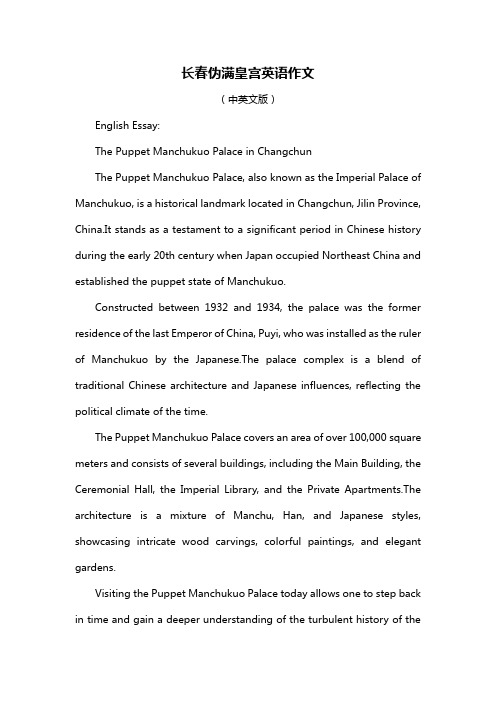
长春伪满皇宫英语作文(中英文版)English Essay:The Puppet Manchukuo Palace in ChangchunThe Puppet Manchukuo Palace, also known as the Imperial Palace of Manchukuo, is a historical landmark located in Changchun, Jilin Province, China.It stands as a testament to a significant period in Chinese history during the early 20th century when Japan occupied Northeast China and established the puppet state of Manchukuo.Constructed between 1932 and 1934, the palace was the former residence of the last Emperor of China, Puyi, who was installed as the ruler of Manchukuo by the Japanese.The palace complex is a blend of traditional Chinese architecture and Japanese influences, reflecting the political climate of the time.The Puppet Manchukuo Palace covers an area of over 100,000 square meters and consists of several buildings, including the Main Building, the Ceremonial Hall, the Imperial Library, and the Private Apartments.The architecture is a mixture of Manchu, Han, and Japanese styles, showcasing intricate wood carvings, colorful paintings, and elegant gardens.Visiting the Puppet Manchukuo Palace today allows one to step back in time and gain a deeper understanding of the turbulent history of theregion.It serves as a reminder of the struggles and sacrifices made by the Chinese people during the Japanese occupation.The palace has been transformed into a museum, displaying a vast collection of artifacts, photographs, and documents from the Manchukuo period.These exhibits provide valuable insights into the political, economic, and cultural aspects of the time, offering a rare glimpse into a forgotten era.In conclusion, the Puppet Manchukuo Palace in Changchun is not only a significant historical site but also a symbol of the resilience and determination of the Chinese nation.It stands as a reminder of the importance of preserving history and learning from the past.中文作文:长春伪满皇宫伪满皇宫,亦称满洲国皇宫,位于吉林省长春市,是中国20世纪初的一个重要历史地标。
伪满皇宫英文作文

伪满皇宫英文作文The Pseudo-Manchurian Palace, also known as the Shenyang Imperial Palace, is a grand palace complex located in Shenyang, Liaoning Province, China. It was built during the Qing Dynasty and served as the imperial palace for two emperors. Today, it is one of the most well-preserved ancient palaces in China and a popular tourist attraction.The palace complex is composed of more than 300 rooms, with a total area of over 60,000 square meters. The architecture of the palace is a blend of Chinese and Manchurian styles, featuring intricate carvings, colorful paintings, and majestic halls. As you walk through the palace, you can feel the grandeur and elegance of the imperial court.One of the most impressive parts of the palace is the Dazheng Hall, which was used for important ceremonies and meetings. The hall has a height of 20 meters and a width of 30 meters, and is decorated with gold, jade, and otherprecious materials. Standing in the hall, you can imagine the emperors and officials discussing state affairs and making important decisions.Another highlight of the palace is the Ten Thousand Buddhas Pavilion, which houses a collection of Buddhist statues and artifacts. The pavilion is surrounded by a tranquil garden, providing a peaceful escape from the hustle and bustle of the city.Visiting the Pseudo-Manchurian Palace is not only a journey through history, but also a cultural experience. You can learn about the customs and traditions of the Manchurian people, as well as the art and architecture of the Qing Dynasty. It is a must-see destination for anyone interested in Chinese history and culture.In conclusion, the Pseudo-Manchurian Palace is a magnificent palace complex that showcases the grandeur and elegance of the Qing Dynasty. With its intricate architecture, beautiful decorations, and historicalsignificance, it is a must-visit destination for anyone traveling to Shenyang.。
伪满皇宫的英语作文怎么写

As a high school student with a keen interest in history, my visit to the Puppet Emperors Palace in Changchun was an eyeopening experience that left a profound impact on me. The Puppet Emperors Palace, also known as the Manchukuo Imperial Palace, is a historical site that serves as a stark reminder of a dark chapter in Chinas past.The palace was the official residence of Puyi, the last Emperor of the Qing Dynasty, during the Japanese occupation of Manchuria in the 1930s and 1940s. It was a time when China was under the brutal rule of the Japanese Empire, and the palace stands as a testament to the atrocities committed during that era.Upon entering the palace grounds, I was immediately struck by the grandeur of the architecture. The buildings, a blend of Chinese and Western styles, are a testament to the cultural fusion that took place during the Japanese occupation. The main building, the Chongde Hall, is a magnificent structure that houses the throne room, where Puyi was forced to sit as the puppet emperor.As I walked through the palace, I couldnt help but feel a sense of sadness and anger. The rooms were filled with artifacts and photographs that depicted the life of Puyi and the Japanese officials who controlled him. It was a stark contrast to the opulence of the palace itself, a symbol of the power and wealth that the Japanese sought to exert over China.One of the most poignant exhibits was the room where Puyi was forced to sign documents that ceded Manchuria to Japan. The room was small anddimly lit, with a simple desk and chair. It was hard to imagine the weight of the decisions that were made in that room, decisions that would have farreaching consequences for the people of China.The palace also houses a museum that provides a detailed account of the history of Manchukuo and the Japanese occupation. The exhibits include photographs, documents, and personal belongings of Puyi and the Japanese officials. It was a chilling reminder of the power dynamics at play during that time and the lengths to which the Japanese were willing to go to maintain control over China.As I walked through the palace, I was struck by the resilience of the Chinese people. Despite the oppression and the hardships they faced, they managed to survive and eventually reclaim their land. The Puppet Emperors Palace serves as a reminder of the strength and determination of the Chinese people, a story that continues to inspire me today.In conclusion, my visit to the Puppet Emperors Palace was a humbling and enlightening experience. It was a stark reminder of the atrocities committed during the Japanese occupation and the resilience of the Chinese people. The palace is not just a historical site, but a symbol of the struggles and triumphs of a nation. It is a place that I will never forget and a lesson that I will carry with me for the rest of my life.。
伪满皇宫的英语作文初一
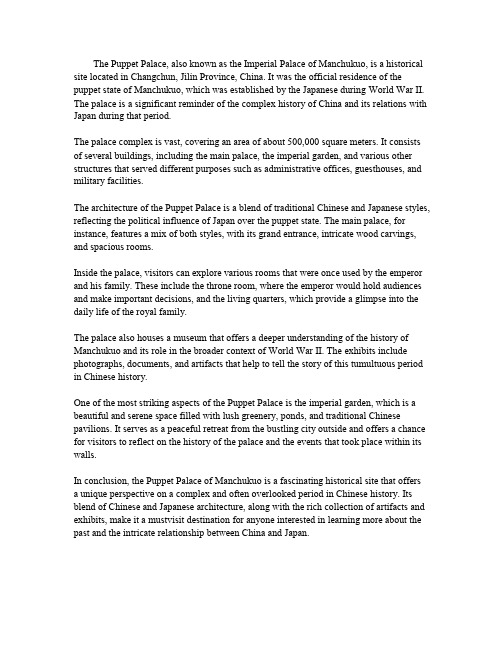
The Puppet Palace, also known as the Imperial Palace of Manchukuo, is a historical site located in Changchun, Jilin Province, China. It was the official residence of the puppet state of Manchukuo, which was established by the Japanese during World War II. The palace is a significant reminder of the complex history of China and its relations with Japan during that period.The palace complex is vast, covering an area of about 500,000 square meters. It consists of several buildings, including the main palace, the imperial garden, and various other structures that served different purposes such as administrative offices, guesthouses, and military facilities.The architecture of the Puppet Palace is a blend of traditional Chinese and Japanese styles, reflecting the political influence of Japan over the puppet state. The main palace, for instance, features a mix of both styles, with its grand entrance, intricate wood carvings, and spacious rooms.Inside the palace, visitors can explore various rooms that were once used by the emperor and his family. These include the throne room, where the emperor would hold audiences and make important decisions, and the living quarters, which provide a glimpse into the daily life of the royal family.The palace also houses a museum that offers a deeper understanding of the history of Manchukuo and its role in the broader context of World War II. The exhibits include photographs, documents, and artifacts that help to tell the story of this tumultuous period in Chinese history.One of the most striking aspects of the Puppet Palace is the imperial garden, which is a beautiful and serene space filled with lush greenery, ponds, and traditional Chinese pavilions. It serves as a peaceful retreat from the bustling city outside and offers a chance for visitors to reflect on the history of the palace and the events that took place within its walls.In conclusion, the Puppet Palace of Manchukuo is a fascinating historical site that offers a unique perspective on a complex and often overlooked period in Chinese history. Its blend of Chinese and Japanese architecture, along with the rich collection of artifacts and exhibits, make it a mustvisit destination for anyone interested in learning more about the past and the intricate relationship between China and Japan.。
介绍伪满皇宫的作文

介绍伪满皇宫的作文英文回答:The Pseudo-Manchu Palace, also known as the Wufangzhai, is a famous tourist attraction located in the city of Shenyang, China. It was built during the Qing Dynasty andis considered a replica of the original Manchu Palace in the Forbidden City in Beijing.The Pseudo-Manchu Palace covers an area of 60,000 square meters and consists of more than 300 rooms. It is a magnificent architectural masterpiece that showcases the unique style and grandeur of the Qing Dynasty. The palaceis known for its intricate carvings, beautiful paintings, and exquisite decorations.One of the highlights of the Pseudo-Manchu Palace is the Hall of Great Affairs, which was used for important ceremonies and meetings during the Qing Dynasty. The hallis adorned with gold and jade, and its walls are decoratedwith intricate murals depicting historical events and legends. Visitors can also explore the imperial gardens surrounding the palace, which feature traditional Chinese landscaping and beautiful pavilions.The Pseudo-Manchu Palace is not only a historical site but also a cultural treasure. It offers visitors a glimpse into the rich history and heritage of China's imperial past. The palace is often used as a venue for cultural events, such as traditional music performances and art exhibitions.中文回答:伪满皇宫,又称为五方寨,位于中国沈阳市,是一处著名的旅游景点。
- 1、下载文档前请自行甄别文档内容的完整性,平台不提供额外的编辑、内容补充、找答案等附加服务。
- 2、"仅部分预览"的文档,不可在线预览部分如存在完整性等问题,可反馈申请退款(可完整预览的文档不适用该条件!)。
- 3、如文档侵犯您的权益,请联系客服反馈,我们会尽快为您处理(人工客服工作时间:9:00-18:30)。
伪满皇宫导游词英文篇一:吉林省英语导游证口试伪满皇宫缉熙楼英语导游词ThePuppetmanchurianimperialPalacemuseum ThePuppetmanchurianimperialPalacemuseum---JixiBuildingJixiBuildingisatwo-storyonewithblackbrick-and-ironroof.itwasoriginallyt heofficebuildingofSaltadministrationofJilinandHeilongjiangprovinces.and aftertherebuildingandrepaironapril3rd,1932,itbecamethedormitoryforPuyi andhisconcubines.PuyinamedthebuildingJixiaccordingtoanancientpoem.T hetwocharactersofJixisymbolizethebrightness.Bycontrast,whenPuyimove din,hefoundthateverythingherewasabsolutelydifferentfromwhatheimagine d.HislifewascontrolledbyJapaneseGuandongarmywithtotalabsenceoffreed omandliberty.(Bedroom)Enteringthebuilding,upalongthestairs,wecometothesecondfloor.Thewestpa rtofthisflooristhelivingquarterofPuyi,whichmainlycontainsbedroom,study, barber’sroom,theroomofBuddists,washingroomandthetraditionchinesemedicinero om.Thebedroomisdecoratedsimplyandbrightly.Thebedismadeofmahogany woodcoveredwithtwodragonsplayingapearl.itissaidthetwosilkpillowsweremadebyPuyi’sconcubineTanYuling.Puyiwasafraidofhotverymuch.Hegotahabbitofcover ingtowelingcoverletwhensleeping,coveringoneinsummerandtwoinwinter. Somepartofhisbodywaswrappedwithacleansheetwhichwaswashedandchan gedeveryday.Strangelyenough,thereweretwohumanmodels,onemale,anoth erfemale,underhiswindowfacingsouth,coveredbyclothinusual.whenhewen ttobed,Puyialwaysputtheminfrontofhisbed.itissaidthattheyservedasPuyi’sbodyguards.(Study) Theroomconnectingwiththebedroomishisstudy.asapuppet,therewerenoaffa irstodealwith,instead,hespentmoreandmoretimeinJixiBuilding.Hisstudybe cameanotheroffice,andheoftenmetYoshiokahere.Generally,withouthisper mit,nobodywasallowedtoenterhisroom.ButYoshiokawasanexception.more over,hecameinandoutseveraltimesaday.Eachtimehecamein,Puyiwouldstan dupandgreethimbecauseoffright.Lookatthispicture.Thepaintingonthewall waspaintedbyYoshioka.althoughitwasnotwelldone,Puyihungitinthepromin entpositionrespectfully.anotherarrestingarticleintheroomwasthemodelof“Hiji”—aworshipofJapan.whenPuyifirstvisitedJapan,Japanesemadethemod eltosendhimtomakehimmoreclosetoJapan.inapril2nd,1935,arrangedbyGua ndongarmy,PuyibeganhisvoyagebytheworshipforJapanindaliancity.during thevoyage,inordertoexpresshisgratefulness,Puyiscriptedapoem: Japantheworshipsailsfor,Theseaisascalmasamirror.withtwostateshandinhand,Theorientalwillbestrongforever.onmay2nd,fivedaysafterPuyi’sreturningfromJapan,heissuedhisinstructiontoadvocatethefriendshipbetwe enJapanandchina.HeoftensaidthatchinaandJapanshouldbeofoneheartandon emind.(Barber’sRoom)Puyi’sbarber’sroomisnotbig,butwell-equiped.TherewasaJapanesehairdresserservinghim only,whosenamewasTsuta.whenhefinishedhisjob,Puyiwouldwrapthehairin ayellowpieceluster,writingtheandkeepingitwelltoshowhischerishofhishair.Besides, itwasthedisinfectingroom.Puyiwasinjectedwithimportedtonichormone,and alltheinstrumentsusedmustbedisinfectedhere.asamysophobia,Puyichanged andwashedhisshirteveryday.Eveninsummer,hebroughtanalcoholboxwithhi manytime.Evenifaflyfellonhisbody,hewouldcleanitwithalcoholcottonincas eofgettinginfected.(RoomofBuddists) PuyihadbeenadevoutBuddistsincehischildhood,sofarastobesuperstitious.w heneverhewentoutorhadimportantactivities,hewoulddivinebymeansoftheE ightdiagramspredictinghisfuture.Sometimesitwouldlastoneortwohoursunti lhewasentirelysatisfiedwithhisoutcome.asJapaneselostitsdominancegradually,Puyiwasathisgloomydays.Eating,sleeping,jerkinglotsanddivingwereth eonlythingshecoulddo.Thepalacewaslikeatemple.Hebeatswoodenfishdaya ndnight.However,Puyishowednosympathytohisservants.Takingtheteenage rsservingascleanersforexample,theywork15~16hoursperdayandtheyhadto workatnight.Theydidthehardestjobandatetheworstfoodsothattheywerethin andpale.Theywouldbepunished,beatenandevenimprisonedforsomelittleerr ors.intheyearof1944,oneoftheteenagersnamedSunBoyuancouldn’tbearthesufferingandtriedtoescapetwice.Hewasbeatentodeathatlast.Puyidi dn’tthinkthatitwashisfaultbutblamedontotheonewhobeatSunBoyuanandpunis hedhim.afterthataccident,heprayedforhimjustbecausehewasafraidoftherev engeofSunBoyuan’sghost.(Bathroom)intheoppositesideofthebedroomwashistoilet,thebathroomandthewashroom .canyoufindsomethingdifferent?Yes.Therewasasmallwoodendeskwithnew spapersandmagazinesonit.why?That’sbecausePuyisufferedserioushemorrhoids,sohehadtositonthetoiletseatforal ongtime.Therefore,hedevelopedintoahabbitofreadingandsigningthememor ialsinthetoilet.Everytimethememorialpresenterhandedthedocumentstohim, hewouldsignthemwithoutreadingit,thendroppedthedocumentsontothefloor. Thepresenterpickedthemuponebyoneandwentout.alotofreactionarydocum entsweresignedinthisway.maybePuyineverthoughthissuchbehavioursbroughtalotofdisasterstothepeopleinthenortheast.(chinesedrugStore) Puyihadbeenunhealthysincehewasachild,orwecansay,hecoulddoctorhimsel fbecausehewasillforalongtime.Hewasevenaddictedtotakingandcollecting medicine.Therefore,hesetupachinesedrugstorebesideshisroom.Puyihadhad readalotofmedicalbooks,whichmadehimamasterofTraditionalchinesemedi cinemoreorless.atthattime,therewerefourimperialdoctorswhodiagnosehim byturn.Everydaytheywouldfeelhispulseevenifhewasnotill.Hewouldaskdoc torforwritingaprescriptionandboilingdownmedicalherbswellservingastea,b utwereuseless.Puyididn’ttakethem.whenhereallywantedtotakemedicine,hewouldaddorreducesome medicineherbsofftheprescriptionbytheimperialdoctorsorhewouldrewritean ewprescriptionandcarrymedicinefromchinesedrugstoreinperson. (wanrong) intheeasternpartofthesecondflooristhelivingquarterofEmpresswanrong,co nsistingofabedroom,astudy,aroomofsmokingopiumandbathroom.wanrong, amanchuinzhengbaiBanner,wasborninTianjinin1906.Shewaswell-educate dandcouldspeakEnglishfluently.Shewasnotonlybeautifulbutalsoexcelledin luteplaying,chess,calligraphyandpainting.Herbeautyandintelligencewerere nownedintheBanner.indecemberof1922,thesixteen-year-old girlwanrongandPuyiheldagreatweddingceremonyintheForbiddencity.inma rchof1932,shecametochangchunwithPuyiandbecametheEmpressofPuppetEmperor.Becauseshedidn’tgetalongwellwithPuyiandherspirituallifewasblank,shehadsecretrelationsh ipwithPuyi’sservant.Puyidesertedherafterheknewthetruth.Fromthenon,shewasdrivenin tothelimboandconfinedtotheeasternpartofthesecondfloor.inordertoremovet heempress,PuyifoundanexcuseoftakinghertoLvshun.Becauseofwanrong’srefusalandJapaneseGuandongarmy’sinterruption,theplanwasinvain.althoughwanronglivedsoneartoherhusband ,infact,shewasisolatedfromoutside.Shecouldn’tseeherrelatives.Shewastorturedbothphysicallyandmentally.inordertoreliev ethepain,shehadnowaybutlayonbedtoanaesthetizeherbysmoking.Heradditi onbecamehavierandhavierdaybyday.Shesmoked100gramsofopiumperday. Everytimesheusedeightpipeswitheighty-fivecigarettes.Sheevencouldn’tlivewithoutopiumandsufferedfromschizophrenia.assheconfinedherselfint heroom,hereyesfearedlightandshealsocouldn’twalknormally.afterthePuppetEmperorcollapsed,wanrongescapedwithPuyi todalizigou,Tonghuacity.onJune20th,1946,wanrongdiedinYanjionthewayo fescaping.ifshewouldn’thavefollowedPuyitochangchunasapuppetempressatthatmoment,howwoul dthebrilliantbeautyhavehadsotragicfate?comparedwithwanrong,anotherim peralconcubinewenxiuwaslucky.Sheenteredthepalaceatthesametimewithw anrong,butshewasanindependentandprogressivefemale.inoctoberof1931,unbearingPuyi’sdesolationandwanrong’sinsult,sheresolutelydevoicedwithPuyiinTianjinandlivedaself-reliantlife.H owever,wanronglovedvanitysomuchthatshebecameavictimofPuyiandfeud alsystem.(TanYuling) inthewesternpartofthefirstfloorofJixiBuildinglivedPuyi’sthirdwife,TanY uling.Thispartcontainsthebedroom,study,sittingroom,livin groomandbathroom.afterwanrongwasputintothelimbo,PuyimarriedTanYul ing,amiddleschoolstudentinBeijingin1937.TanYulingwaschosenbyPuyiatt heageof17.ShewassoconsideratethatwhenPuyigotangryandshoutedather,or evenhetoreherclothes,shewouldnotgetannoyed.onthecontary,shewouldtryt opersuadePuyitocalmhimselfdown.Hence,shewonhisfavor.onthewaytocha ngchuncity,shewitnessedwhattheJapanesehaddonetothechinesepeople,soin chattingwithPuyi,shewouldslightlyexposeherdissatisfaction.in1942,shebe cameillandwasconsideredbeinginfectbytyphoidfever.Butthemedicinedidn ’ter,withtherecommendationofYoshioka,aJapane sedoctornamedounoderacametotureher.ounoderabelievedthatshehadgottub erculosisandbeganhistreatment.However,allhiseffortfailed.Finallyafterthe doctorhadalongtalkwithYoshioka,heinjectedsomethingtoher.andshediedbe forethenextdawnattheageof22.Herdeathremainsamysterytilltoday.Puyisus pectedthattheJapanesekilledherandheevenexclaimedthisonthemilitarycour t.inordertomemorizeTanyuling,Puyiwrotedown“Yulingmybeloved”onthebackofherphoto.Furthermore,theemperorevenkepthernailsandawispofherbl ackhairtogetherwiththephotointoawalletandbroughtitwhereverhewent.onh erfuneral,PuyiarrangedmanyspecializedorchidsnamedJunzilantobeputalon ghercoffin,fortheseflowerswereTanyuling’sfavoriteandalsopeculiarwithinPuyi’tertheseorchidswerebredint hetempleandbecamethemostfamoustypeoforchids.Thefolkscalledthem“he shangtou”meaningtheheadofmonks.Untilthecollapseofthepuppetregime,P uyifinallyagreedtocremateherbodyandtheasheswastakentoBeijing.withsev eralturnarounds,Tanyuling’sasheswerekeptinthismuseumafterall. ThevisitofJixiBuildingisover.PleasefollowmetoTongdeBuilding.篇二:伪满皇宫缉熙楼导游词伪满皇宫缉熙楼导游词女士们先生们:大家好!欢迎您欢迎各位到长春伪满皇宫缉熙楼观光旅游。
